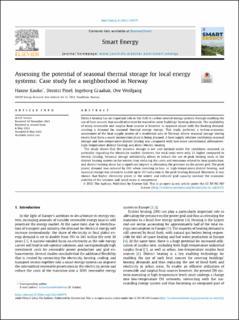| dc.contributor.author | Kauko, Hanne | |
| dc.contributor.author | Pinel, Dimitri | |
| dc.contributor.author | Graabak, Ingeborg | |
| dc.contributor.author | Wolfgang, Ove | |
| dc.date.accessioned | 2022-07-21T10:30:57Z | |
| dc.date.available | 2022-07-21T10:30:57Z | |
| dc.date.created | 2022-06-15T09:01:07Z | |
| dc.date.issued | 2022 | |
| dc.identifier.issn | 2666-9552 | |
| dc.identifier.uri | https://hdl.handle.net/11250/3007502 | |
| dc.description.abstract | District heating has an important role in the shift to carbon-neutral energy systems through enabling the use of heat sources that would otherwise be wasted to cover buildings’ heating demands. The availability of many renewable and surplus heat sources is however in opposite phase with the heating demand, creating a demand for seasonal thermal energy storage. This study performs a techno-economic assessment of the heat supply system of a residential area in Norway, where seasonal storage storing excess heat from a waste incineration plant is being planned. A heat supply solution combining seasonal storage and low-temperature district heating was compared with two more conventional alternatives: high-temperature district heating and direct electric heating. The study shows that the seasonal storage is not cost optimal under the conditions assumed, in particular regarding the electricity market; however, the total costs were only 3% higher compared to electric heating. Seasonal storage additionally allows to reduce the use of peak heating units in the district heating system in the winter, thus reducing the costs and emissions related to heat production, and district heating alone has a significant impact in alleviating the pressure on the power grid. The peak power demand was reduced by 28% when investing to low- or high-temperature district heating, and seasonal storage was shown to enable up to 31% reduction in the peak heating demand. Moreover, it was shown that higher electricity prices in the winter and reduced grid capacity increase the economic viability of the solution and could make it competitive. © 2022 The Authors | en_US |
| dc.description.abstract | Assessing the potential of seasonal thermal storage for local energy systems: Case study for a neighborhood in Norway | en_US |
| dc.language.iso | eng | en_US |
| dc.publisher | Elsevier | en_US |
| dc.rights | Attribution-NonCommercial-NoDerivatives 4.0 Internasjonal | * |
| dc.rights.uri | http://creativecommons.org/licenses/by-nc-nd/4.0/deed.no | * |
| dc.title | Assessing the potential of seasonal thermal storage for local energy systems: Case study for a neighborhood in Norway | en_US |
| dc.title.alternative | Assessing the potential of seasonal thermal storage for local energy systems: Case study for a neighborhood in Norway | en_US |
| dc.type | Peer reviewed | en_US |
| dc.type | Journal article | en_US |
| dc.description.version | publishedVersion | en_US |
| dc.rights.holder | The Authors | en_US |
| dc.source.volume | 6 | en_US |
| dc.source.journal | Smart Energy | en_US |
| dc.identifier.doi | 10.1016/j.segy.2022.100075 | |
| dc.identifier.cristin | 2031913 | |
| dc.relation.project | Norges forskningsråd: 257660 | en_US |
| dc.relation.project | EC/H2020/835896 | en_US |
| dc.source.articlenumber | 2031913 | en_US |
| cristin.ispublished | true | |
| cristin.fulltext | original | |
| cristin.qualitycode | 1 | |

